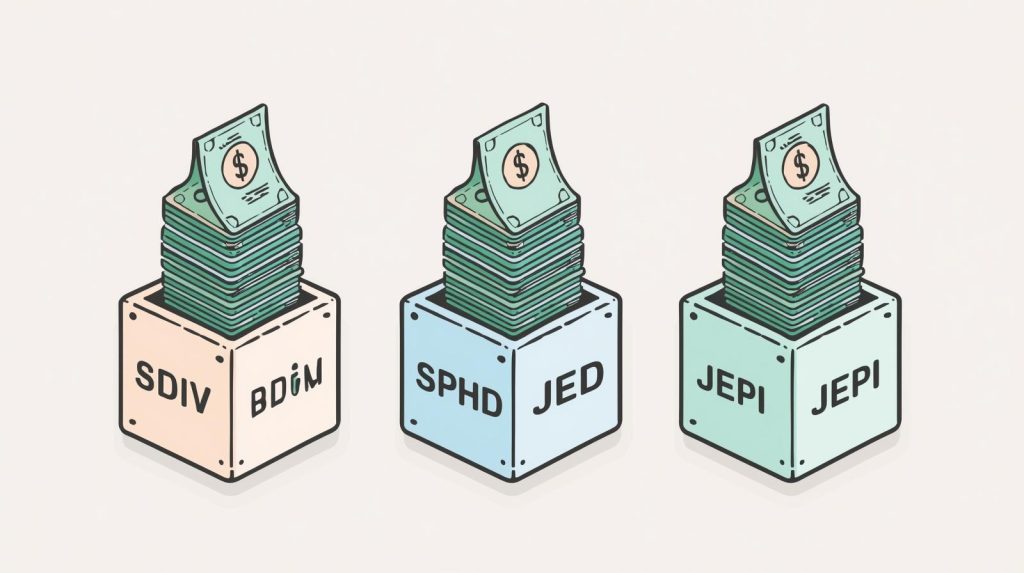
Why Dividend ETFs Appeal to Income Investors
For many investors, steady cash flow is just as important as long-term growth. Dividend ETFs have become increasingly popular because they provide regular income, diversification, and professional management. In particular, funds that pay dividends monthly attract retirees, conservative investors, and anyone seeking predictable cash flow.
As we enter 2025, several dividend ETFs stand out for their ability to deliver reliable monthly income while balancing risk and performance.
What Makes a Good High Dividend ETF?
Dividend Yield vs. Total Return
While a high yield looks attractive, it’s important to consider total return. Some ETFs with extreme yields may sacrifice capital appreciation or invest in risky companies. The best ETFs balance yield with sustainable growth.
Monthly vs. Quarterly Payouts
Most traditional dividend ETFs pay quarterly. However, certain ETFs are designed to distribute income every month, making them particularly useful for investors who rely on dividends to cover living expenses.
Top 3 High Dividend ETFs for 2025
ETF 1 – Global X SuperDividend ETF (SDIV)
The Global X SuperDividend ETF (SDIV) is designed to provide one of the highest dividend yields available in the ETF space. It invests in 100 of the highest-yielding equity securities globally.
- Pros: Very high dividend yield, monthly payouts, global diversification.
- Cons: High risk due to exposure to volatile markets and companies with unstable fundamentals. Performance may lag during market downturns.
ETF 2 – Invesco S&P 500 High Dividend Low Volatility ETF (SPHD)
The Invesco SPHD focuses on 50 of the highest dividend-yielding, low-volatility stocks from the S&P 500.
- Pros: Balance of yield and risk management, steady monthly payouts, large-cap U.S. companies.
- Cons: Lower yield than ultra-high-yield ETFs, but more sustainable in the long term.
ETF 3 – JPMorgan Equity Premium Income ETF (JEPI)
The JPMorgan Equity Premium Income ETF (JEPI) has become one of the most popular income ETFs in recent years. It combines dividend-paying stocks with an options overlay strategy to generate additional income.
- Pros: Strong monthly income, relatively lower volatility, backed by JPMorgan’s active management.
- Cons: Higher expense ratio than passive ETFs, and performance may lag in strong bull markets due to its option strategy.
Comparing Key Metrics
Yield and Expense Ratios
- SDIV: Yield around 12%+, expense ratio ~0.59%.
- SPHD: Yield around 4–5%, expense ratio ~0.30%.
- JEPI: Yield around 7–9%, expense ratio ~0.35%.
Performance History
- SDIV: Attractive yield but weaker long-term capital appreciation.
- SPHD: Solid performance with reduced volatility compared to broader markets.
- JEPI: Strong growth since inception, widely adopted by income-focused investors.
Risk Factors
- SDIV: High volatility, global exposure risk.
- SPHD: Moderate risk, lower drawdowns in market corrections.
- JEPI: Strategy-dependent risks, limited upside in bull markets.
Which ETF Fits Different Investor Profiles?
- Conservative investors: SPHD offers balanced income with lower volatility.
- Aggressive income seekers: SDIV delivers maximum yield but comes with higher risk.
- Balanced approach: JEPI provides a blend of strong monthly income and managed risk.
Practical Tips for Building Monthly Income with ETFs
- Diversify among income ETFs. Don’t rely on a single fund.
- Reinvest dividends if you don’t need the cash. This compounds returns.
- Balance yield with risk. A 12% yield means nothing if the capital erodes.
- Align with your financial goals. Retirees may prioritize stability, while younger investors may reinvest aggressively.
Final Thoughts: Balancing Income and Risk
High dividend ETFs are powerful tools for generating monthly income, especially in 2025’s uncertain market environment.
- SDIV offers maximum yield but with volatility.
- SPHD provides stability with moderate income.
- JEPI combines innovation with consistent payouts.
The right choice depends on your risk tolerance and income needs. For many investors, combining two or more of these ETFs may provide both steady income and portfolio balance.
Leave a Reply